Pulmonary hypertension (PH) is a rare however severe problem that in tonerin inhaltsstoffefluences the capillary in the lungs, bring about hypertension in the lung arteries. This can cause different difficulties and considerably influence an individual’s lifestyle. To better understand and also take care of PH, the World Health Organization (THAT) has actually classified the condition right into five unique teams based on their underlying causes and also therapy strategies. In this write-up, we will check out each of these teams and also talk about the available treatment alternatives.
Group 1: Lung Arterial Hypertension (PAH)
Group 1 consists of PAH, a condition identified by the narrowing and stiffening of the tiny blood vessels in the lungs. This results in increased resistance in these vessels, compeling the heart to function more challenging to pump blood through them. PAH can be acquired or idiopathic (of unknown reason) as well as can likewise happen as a result of various other medical conditions such as connective cells illness, liver disease, or HIV infection.
Therapy options for PAH aim to boost symptoms, sluggish condition development, and enhance total lifestyle. Medications such as endothelin receptor villains, phosphodiesterase-5 inhibitors, as well as prostacyclin analogs are frequently prescribed to take care of signs and symptoms as well as boost workout capability. In some cases, lung hair transplant may be considered for individuals with extreme PAH.
Group 2: Lung Hypertension Due to Left Heart Disease
Team 2 PH occurs as a complication of left heart problem such as left ventricular dysfunction or valvular heart problem. These problems hinder the heart’s ability to successfully pump blood, bring about increased stress in the lung arteries. Managing the hidden heart disease is crucial in treating Group 2 PH. This might include medicines to boost heart function, valve repair service or replacement, as well as lifestyle modifications to minimize stress on the heart.
Sometimes, if the heart condition can not be efficiently managed, a heart transplant might be taken into consideration as a therapy alternative for Group 2 PH. Nevertheless, this is a facility and very specialized procedure with its dangers and also considerations.
Group 3: Lung High Blood Pressure Because Of Lung Diseases and/or Hypoxia
Group 3 PH is related to chronic lung diseases such as persistent obstructive pulmonary illness (COPD), interstitial lung condition, or rest apnea. These conditions can result in reduced oxygen levels in the blood (hypoxia) and raised pressure in the pulmonary arteries. Treating the underlying lung illness or dealing with hypoxia is vital in managing Team 3 PH.
Sometimes, extra oxygen therapy may be prescribed to improve oxygen levels in the blood. Medicines such as phosphodiesterase-5 preventions or endothelin receptor villains can also be used to ease signs and symptoms and improve workout capability.
Group 4: Lung Hypertension As A Result Of Persistent Thromboembolic Lung Hypertension (CTEPH)
Group 4 PH is brought on by persistent blood clots in the lungs, typically resulting from a problem called chronic thromboembolic pulmonary high blood pressure (CTEPH). These embolism block the pulmonary arteries, leading to boosted stress in the lungs. Curing Group 4 PH involves addressing the underlying blood clotting disorder or removing the clots through a specialized operation called pulmonary endarterectomy.
In situations where pulmonary endarterectomy is not feasible or not successful, medications such as riociguat, a soluble guanylate cyclase stimulant, may be recommended to manage signs and also boost workout capability.
Group 5: Pulmonary High Blood Pressure with Uncertain and/or Multifactorial Systems
Team 5 incorporates PH situations that do not fit into the other well-known teams or have complex underlying reasons. These situations typically call for a multidisciplinary approach, involving experts from numerous areas such as pulmonology, cardiology, and rheumatology, to establish one of the most appropriate therapy technique. The objective is to determine as well as handle the adding aspects that bring about PH, which may consist of resolving underlying medical conditions, way of living alterations, and targeted medications based on specific needs.
- Normal follow-up: Despite the group category, individuals with PH require normal follow-up check outs with their doctor to check condition progression, readjust treatment strategies, and also resolve any type of emerging problems.
- Lifestyle modifications: In addition to medical therapies, taking on a healthy and balanced lifestyle depanten cooling gel can considerably boost the monitoring of PH. This includes regular exercise, cigarette smoking cessation, maintaining a healthy weight, and taking care of tension degrees.
- Support groups: Dealing with PH can be tough, both literally and also mentally. Signing up with support groups or looking for counseling can supply beneficial assistance and resources for people as well as their caretakers.
It is essential to note that the therapy options stated in this article are basic suggestions and may differ based upon specific situations. Just a certified medical care specialist can offer personalized advice as well as create a customized treatment prepare for individuals with pulmonary high blood pressure.
In Conclusion
Lung hypertension that groups offer a classification system that helps healthcare experts much better understand as well as manage this intricate condition. By categorizing PH right into distinct groups, it becomes feasible to establish targeted treatment techniques based upon the one-of-a-kind underlying causes. While existing therapies can not treat PH, they can dramatically improve signs and symptoms, slow disease progression, and improve quality of life for people living with this problem.
Recommendations:
– Globe Wellness Company.(2018 ). WHO Group Category of Pulmonary Hypertension. Retrieved from [source]
– Galiè, N., et al.(2015 ).2015 ESC/ERS Standards for the medical diagnosis as well as treatment of pulmonary high blood pressure: The Joint Job Force for the Medical Diagnosis as well as Treatment of Lung Hypertension of the European Culture of Cardiology (ESC) and the European Respiratory System Culture (EMERGENCY ROOMS): Endorsed by: Organization for European Paediatric as well as Congenital Cardiology (AEPC), International Culture for Heart and Lung Transplantation (ISHLT). European Heart Journal, 37( 1 ), 67-119.
Einsatzort & Bereich



